Spain’s Basque Country an immersion in style, beauty, comfort against backdrop of great food
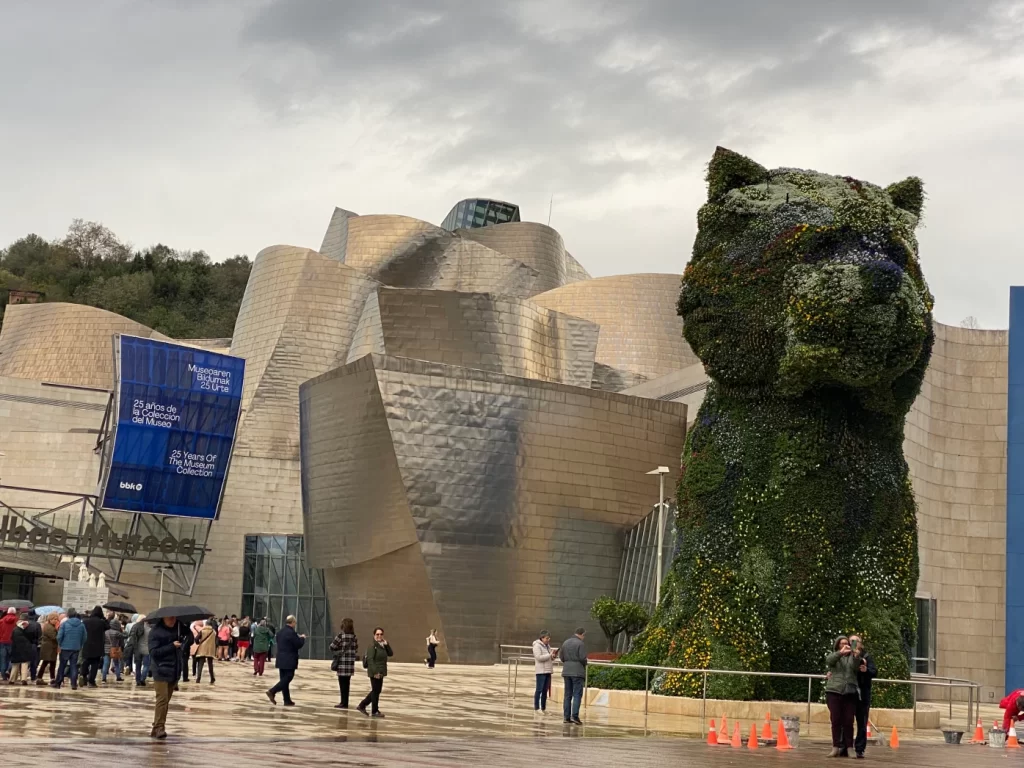
“Puppy,” a three-story-tall installation created from plants marks an entrance to the Guggenheim Museum in Bilbao, was designed by Jeff Koons. (Janet Podolak)
A quest to gratify a lifelong curiosity about Spain’s Basque Country led me to a wonderful week’s immersion into stylish elegance with great food, glorious scenery and exceptionally comfortable lodging. Sequestered much like an island at the edge of France and the Atlantic’s Bay of Biscay, with its own flag, languages, customs and history, Basque Country is a place apart — recognized by Spain as an autonomous regional province.
Its ancient language, Euskera, which distinguishes Basque from the rest of the world, is rich with x, t and z sounds and seems unpronounceable at first. It is not related to any other spoken tongue. Just last month archaeologists traced inscriptions on a bronze hand to the iron age Vascone, a tribe that inhabited the area before the first century arrival of the Romans. And it’s believed that Basque fishermen, in seafaring forays after cod and whales, may have been in North America even before Columbus.
“Txikitear” in Basque means going from bar to bar and sampling small glasses of wine with delicious pintxos, pronounced “pinchos.” It’s the pintxos, in fact, that probably account for Basque Country’s reputation for having the finest food in all of Spain. Twenty Michelin-starred restaurants are found in this compact area, but “pinchos” is one of the most important Basque words to know.
Exquisite design follows the visitor into every part of Basque Country, from beautiful spiral staircases to elaborately draped windows and manicured grounds dotted with sculptures that invite touching. Just as those who create beauty often come from alluring places, fashion designer Cristobal Balenciaga and sculptor Eduardo Chillida left behind creations to enjoy in northern Spain.

A spiral staircase off the rooftop dining room at the Hotel Gran Domine Bilbao is a perfect metaphor for the stylish beauty that surrounds a visitor to Spain’s Basque Country. (Janet Podolak)
The Guggenheim Museum, which put Bilbao on the map for visitors, characterizes the dedication to beauty throughout Basque Country.
Light follows the trajectory of the asymmetrical titanium-wrapped folds of Bilboa’s Guggenheim Museum, designed in the 1990s by Canadian-American architect Frank Gehry. It transformed the Pittsburgh-like steel town into an attraction perched at the edge of the Nervion River. A work of art inside and out, its contemporary exhibits invite participation and engagement by the viewer. Marking one entrance is “Puppy,” a 30-foot-tall work by Jeff Koons, made from living vines, flowers and plant material that seemed to thrive in the wet weather during my November visit.
Gehry, who takes his inspiration from his subjects, designed Cleveland’s Peter B. Lewis Building to symbolize Case Western Reserve University’s Weatherhead School of Management’s innovative approaches to management education, according to Cleveland Historical.
My room at Hotel Gran Domine Bilbao overlooked the Guggenheim, with day-to-night experiences of its ever-changing colors as clouds and light moved across the sky.
The bed’s mounds of pillows, napped in the finest linens, absorbed jet lag as I hugged them to support my rotator cuff and tucked them under my neck. It was most difficult to extract myself the next morning.
But Basque Country awaited.
An outdoor escalator in the hillside village of Getaria takes visitors to the Balenciaga Museum, a showcase for the Spanish fashion designer’s gowns.
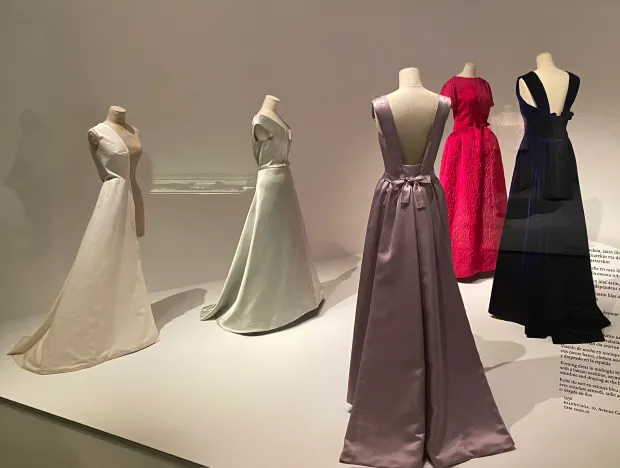
Balenciaga-designed gowns showcase fashion changes through the years. He was born and worked in Basque Country. (Janet Podolak)
Although Balenciaga worked in Spain, France and New York, labels carrying the name Eisa all are made in Spain. A stroll among the artful displays shows how waistlines and other fashion details changed in the ‘50s to ‘70s.
I found a beautifully designed beret in the museum’s gift shop and learned that berets originated, not in France, but here in Basque Country. They still are worn by an older generation, mostly men.
Not far from San Sebastian we stretch our legs in the lovely park-like setting of Chillida-Leku Museum, where the work of sculptor Eduardo Chillida makes the spirit soar. A restored 16th-century barn amid 27 landscaped acres shows off his drawings and small sculptures, while the essence of his work is scattered around outdoors. Rendered in weathered steel, alabaster, stone and concrete, the large outdoor sculptures beg for walk-arounds, touches and selfies.
Gaze upward to the luxurious gilded window treatments of the dining room of the 1912 Hotel Maria Cristina, just steps from the sea in San Sebastian, where an earlier generation of aristocrats spent months at a time. The favored suite of actor Bette Davis, a film star of the ‘40s and ‘50s, carries her name and is decorated with photos from her 50-year career. Johnny Depp and Woody Allen have stayed there more recently.

The graceful drape of gilded window treatments in the Hotel Maria Cristina dining room, in the seaside village of San Sebastian, shows the attention to detail that has drawn royalty and aristocrats since 1912. (Janet Podolak )
Look out along the coast and you’ll see France.
The rich colors of autumn vineyards are a patchwork of red, green and yellow where the Hotel Marques de Riscal rises flamboyantly among ancient stone villages in the Rioja wine district. It’s clear that Gehry took inspiration from the vines, here sheltered from the north winds by the moody Sierra de Cantabria mountains.
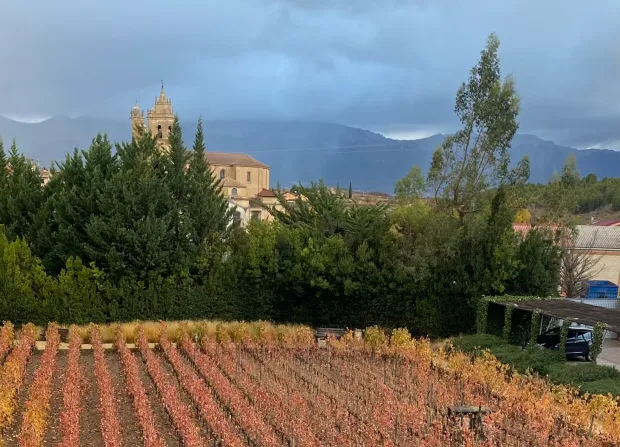
The moody Sierra de Cantabria mountains shelter vineyards in the foreground from the cold north wind while an exceptional view of a stone church is framed for a viewer from a Hotel Marques de Riscal guest room balcony. (Janet Podolak)
Gehry imagined the hotel as a Chateau of the 21st century, showcasing one of the oldest vineyards in Spain. Minimalist interiors for its 61 rooms have fine-grained ash, claret-red walls and dark grey-green marble. Since opening in 2006, it has become one of the world’s most iconic hotels, surrounded by vineyards and breathtaking views of the medieval stone village of Elciego.
Titanium strips of pink, gold and silver wrap the sandstone building’s exterior just as the Marques de Riscal winery’s bottles are wrapped in gold mesh with a silver cap.

Frank Gehry’s Hotel Marques de Riscal, inspired by its surrounding vineyards, changes color day and night. (Janet Podolak)
Like the Guggenheim in Bilbao, it changes with the time of day and movement of the clouds.
The Marques de Riscal winery began in 1862, and wines from that year still are preserved in the underground spaces beneath the vines. A tour of the historic wine cellar reveals the 150-year-old oak casks used for aging are elevated so early winemakers could build a fire beneath them to stimulate the fermentation process.
The tour ends with a tasting of its wines, which are reasonably priced and available locally. I can only hope drinking this wine at home will recapture for me the intrinsic beauty of the Basque Country.
Places in this story are just a few minutes’ drive from each other in Basque Country, a compact region of north central Spain near the Atlantic Ocean and France.
Plan a visit with assistance from tourism.euskadi.eus and spain.info. Our guide, Basque native Aitor Delgado, can be engaged to lead tours. Contact him at aitordelgado.com.

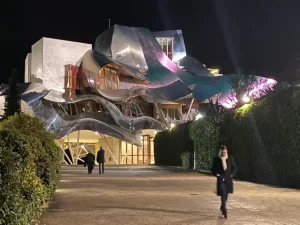
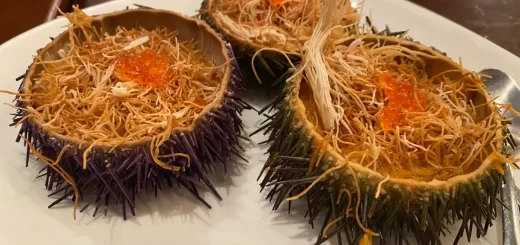


Recent Comments